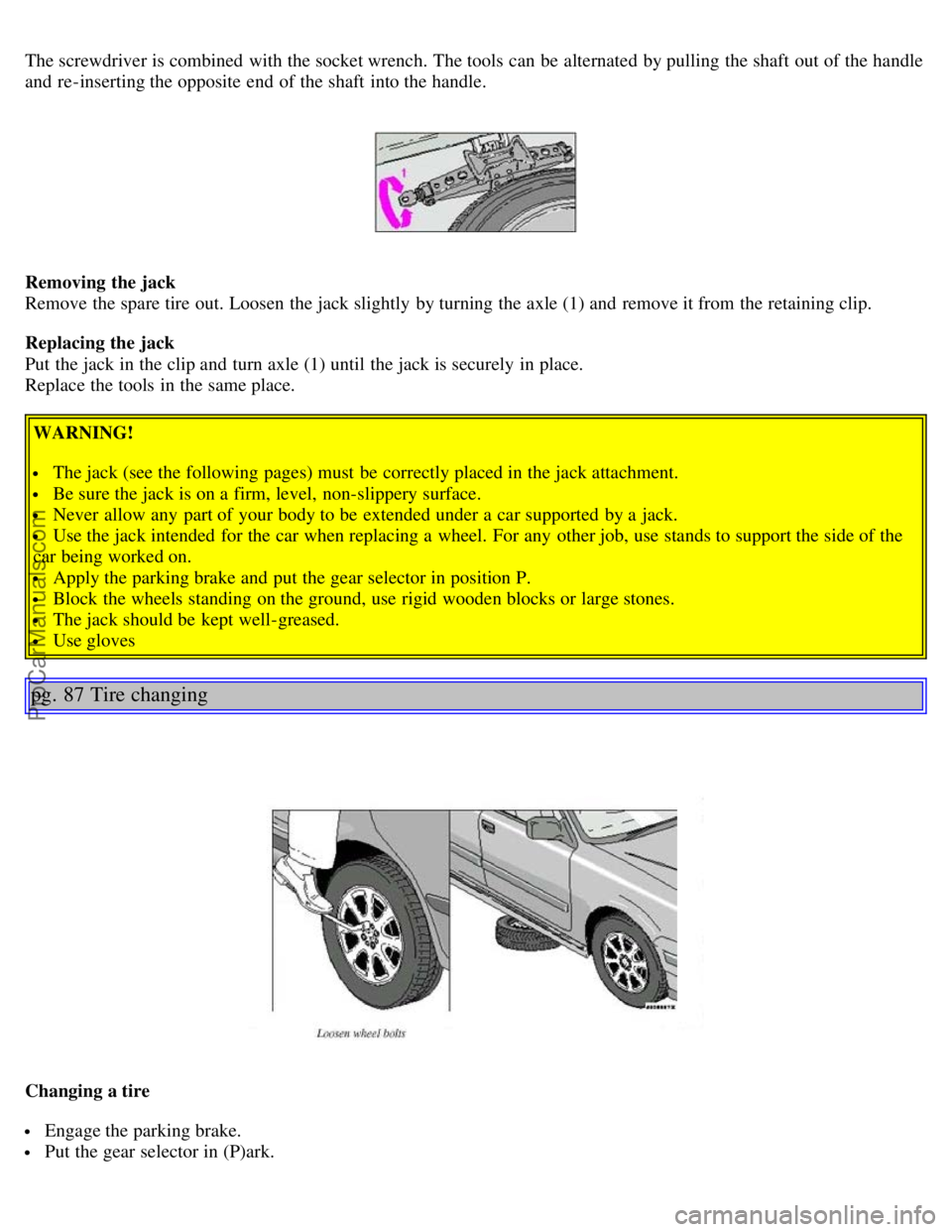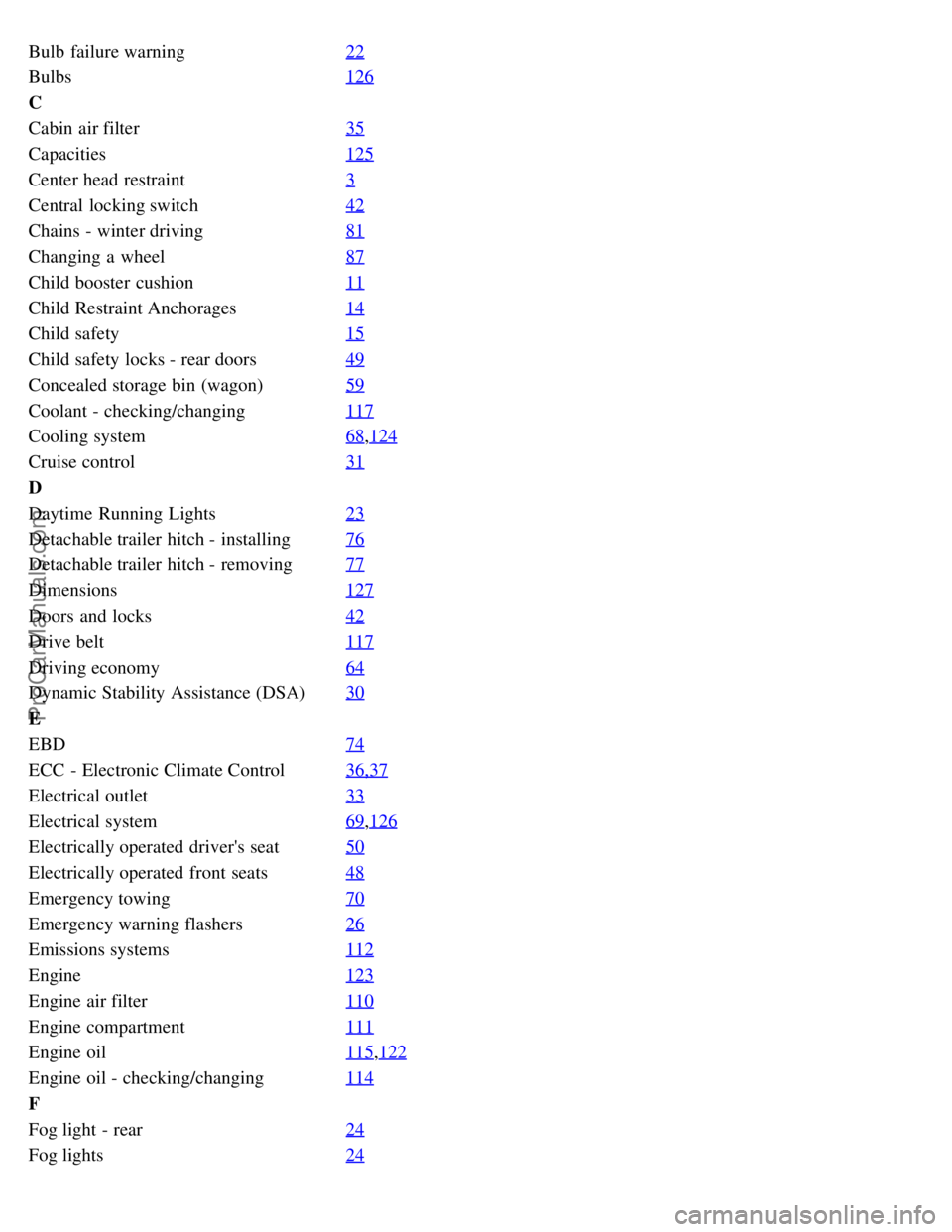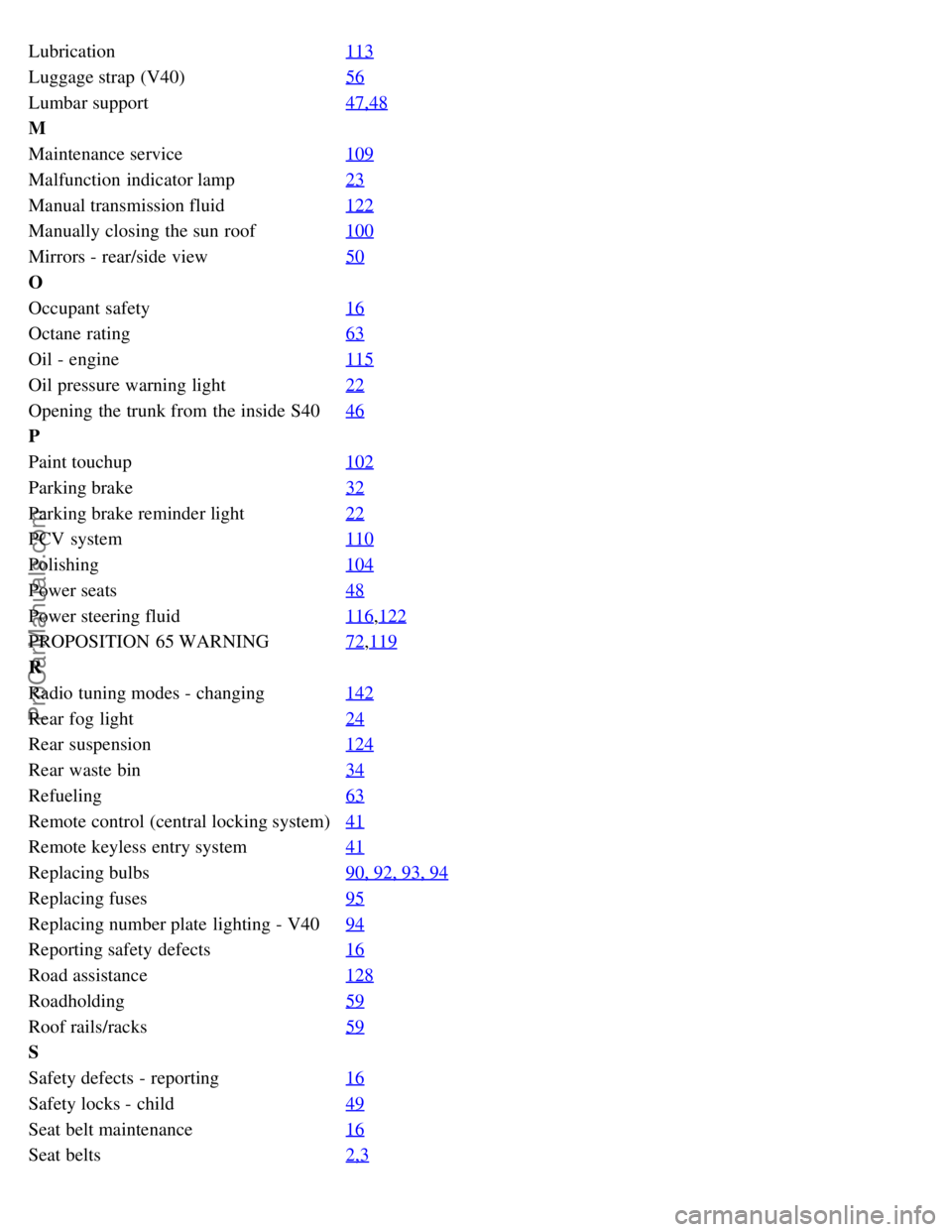warning light VOLVO V4 2003 User Guide
[x] Cancel search | Manufacturer: VOLVO, Model Year: 2003, Model line: V4, Model: VOLVO V4 2003Pages: 85, PDF Size: 1.75 MB
Page 31 of 85

Note that roof racks, ski racks, etc., increase air resistance and thereby fuel consumption.
Avoid using automatic transmission kick-down feature unless necessary.
Avoid using the air conditioning when it is not required. When engaged, the air conditioner's compressor places an
additional load on the engine. However, please note that fuel consumption is lower with the air conditioning on than it
is when driving with the air conditioning switched off and the windows down.
Utilizing the fuel consumption modes in the Trip Computer can help you "learn" how to drive more economically.
Other factors which decrease gas mileage are:
Dirty air cleaner
Dirty engine oil and clogged oil filter
Dragging brakes
Incorrect front end alignment
Some of the above mentioned items and others are checked at the standard Maintenance Service intervals.
NOTE : The automatic transmission's ( D)rive position should be used as often as possible to help improve fuel
economy.
WARNING!
It is recommended that tires of the same make and dimensions be used on all four wheels (including the use of
snow tires). Do not use bias ply tires as this will adversely alter vehicle handling characteristics. Maintain correct tire
pressure.
Do not drive with trunk lid open! A warning light in the instrument panel will indicate that the trunk is open.
Poisonous exhaust gases may enter via the open trunk lid. If the trunk lid/tailgate must be kept open for any reason,
proceed as follows:
Close the windows.
Set the ventilation system control to air flow to floor, windshield and side windows and blower control to its
highest setting.
pg. 65 Starting the engine
Starting and stopping
1. Fasten the seat belt.
WARNING!
Before starting, check that the seat, steering wheel and mirrors are adjusted properly. Make sure the brake pedal can
be depressed completely. Move the seat closer if necessary. Refer to section "front seats".
2. Make sure the gear selector is in the Park position.
3. Without touching the accelerator pedal, turn the ignition key to the starting position. Allow the starter to operate
for up to 5 seconds. Release the key as soon as the engine starts. If the engine fails to start, repeat step 3.
For cold starts at altitudes above 6000 ft (1800 meters), depress the accelerator pedal halfway and turn the key to the
starting position. Release the pedal slowly when the engine starts. Depress the brake pedal and release the parking
brake.
4. To release the gear selector from the (P)ark position, the ignition key must be in position II and the brake pedal
must be depressed.
ProCarManuals.com
Page 32 of 85

NOTE: Your car is equipped with a KEYLOCK system. When the engine is switched off, the gear selector must be in
the (P)ark position before the starting key can be removed from the ignition switch.
5. Select the desired gear. The gear engages after a slight delay which is especially noticeable when selecting R.
CAUTION :
The engine should be idling; never accelerate until after you feel the gear engage! Too rapid acceleration immediately
after selecting a gear will cause harsh engagement and premature transmission wear.
NOTE : Selecting P or N when idling at a standstill for prolonged periods of time will help prevent overheating of
transmission oil.
Ignition sleep mode
If the key is turned to "drive" position (see page 26
) for several minutes without the engine running, the car's starting
system will power down to "sleep" mode. To start the car, momentarily turn the key back to the "locked" position.
Then start the car as you would normally do.
WARNING!
Always place the gear selector in Park and apply the parking brake before leaving the vehicle. Never leave the car
unattended with the engine running.
Always open the garage doors fully before starting the engine inside a garage to ensure adequate ventilation. The
exhaust gases contain carbon monoxide, which is invisible and odorless but very poisonous.
CAUTION:
Never race the engine immediately after starting. Oil flow may not reach some lubricating points fast enough to
prevent engine damage.
Do not race the engine just prior to switching off!
pg. 66 Automatic transmission
Gear selector positions
P Park
The transmission must be in Park position to start the engine, and to allow removal of the key from the ignition when
you leave the car. The car should be stationary when you select P! In the position P the transmission is mechanically
locked. Always apply the parking brake when parking!
ProCarManuals.com
Page 42 of 85

The screwdriver is combined with the socket wrench. The tools can be alternated by pulling the shaft out of the handle
and re-inserting the opposite end of the shaft into the handle.
Removing the jack
Remove the spare tire out. Loosen the jack slightly by turning the axle (1) and remove it from the retaining clip.
Replacing the jack
Put the jack in the clip and turn axle (1) until the jack is securely in place.
Replace the tools in the same place.
WARNING!
The jack (see the following pages) must be correctly placed in the jack attachment.
Be sure the jack is on a firm, level, non-slippery surface.
Never allow any part of your body to be extended under a car supported by a jack.
Use the jack intended for the car when replacing a wheel. For any other job, use stands to support the side of the
car being worked on.
Apply the parking brake and put the gear selector in position P.
Block the wheels standing on the ground, use rigid wooden blocks or large stones.
The jack should be kept well-greased.
Use gloves
pg. 87 Tire changing
Changing a tire
Engage the parking brake.
Put the gear selector in (P)ark.
ProCarManuals.com
Page 58 of 85

WARNING!
The coolant fan may start or continue to operate (for up to 6 minutes) after the engine has been switched off.
pg. 112 Fuel/emissions systems
Fuel system
The fuel system is all-electronic and is microprocessor-controlled. It can continually compensate for variation in
engine load, speed and temperature to give the best economy and power. A mass air flow sensor measures the inducted
air. In this way the system can make instantaneous adjustments for changes in air temperature or density, thus always
assuring the best economy with the lowest possible exhaust emissions.
Heated oxygen sensor
This is an emission control system designed to reduce emissions and improve fuel economy. The heated oxygen sensor
monitors the composition of the exhaust gases leaving the engine. The exhaust gas analysis is fed into an electronic
module. This adjusts the air-fuel ratio to provide optimum conditions for combustion and efficient reduction of the
three major pollutants (hydrocarbons, carbon monoxide and oxides of nitrogen (NOx)) by a three-way catalytic
converter.
Crankcase ventilation
The engine is provided with positive crankcase ventilation which prevents crankcase gases from being released into the
atmosphere. Instead, the crankcase gases are admitted to the intake manifold and cylinders.
Evaporative control system
The car is equipped with an evaporative control system which prevents gasoline vapor from being released into the
atmosphere.
The system consists of a fuel tank with filler pipe and cap, a rollover valve, a Fill Limit Vent Valve (FLVV), vapor
vent lines, a charcoal canister, a purge line, a purge control valve and engine connections. In addition, there is a
pressure sensor connected to the fuel tank and a filter -protected Canister Close Valve (CCV) on the atmospheric side
of the canister, for system diagnosis.
The gasoline vapor is channeled through the rollover valve and the FLVV via the vapor vent lines into the charcoal
canister, where it is stored. When the engine is started, the gasoline vapor is drawn from the charcoal canister to the
engine's air intake system and into the combustion process.
NOTE:
If the fuel filler cap is not closed tightly or if the engine is running when the car is refueled, the Check Engine light
ProCarManuals.com
Page 63 of 85

Fuel tank : 16 US gal. (60 liters)
Cooling system : 6 US qts. (5.7 liters)
Engine oil (incl. filter) : 5.7 US qts. (5.4 liters)
Engine oil (excl. filter) : 5.3 US qts. (5.0 liters)
Automatic transmission : 8 US qts (7.6 liters)
Power steering fluid : 1.05 US qts (1 liters)
Washer fluid reservoir : 3.9 US qts. (3.75 liters)
Brake system : 0.42 US qts (0.4 liters)
Vehicle loading
The tires on your Volvo should perform to specifications at all normal loads when inflated as recommended on the tire
information label. The label is located on the inside of the fuel filler door. The label also lists vehicle load limits. Do
not load your car beyond the indicated limits.
WARNING!
Improperly inflated tires will reduce tire life, adversely affect vehicle handling and can possibly lead to failure
resulting in loss of vehicle control without prior warning.
All specifications are subject to change without notice.
pg. 126 Specifications
Electrical system
12 Volt, negative ground.
Voltage-controlled generator. Single-wire system with chassis and engine used as conductors.
Battery
Voltage: 12 Volt, capacity: 600 A/100 min
The battery contains corrosive and poisonous acids. It is of the utmost importance that old batteries are disposed of
correctly. Your Volvo retailer can assist you in this matter.
Generator
Rated output: 120 A
Bulbs
Bulb US no.Power Socket No/bulbs
Headlights
High beam H755W - 2
Low beam H755W - 2
Parking lights and Turn signals, front 3457NA26/7W/30/2.2cp W2.5 16q 2
Turn signals, rear 115621W/32cp BA 15 s 2
Side direction indicators -5W W 2.1x9.5 d 2
Tail lights 675W/4cp BA 15 s 4
Brake lights 115621W/32cp BA 15 s 2
Backup lights 115621W/32cp BA 15 s 2
Rear fog light 115621W/32cp BA 15 s 1
Front fog lights H355 W PK22.5 2
ProCarManuals.com
Page 77 of 85

2 0 0 3
VOLVO
S40 & V40
INDEX
pg. 143 - 145 Index
A
ABS 23
,73
Adjustable steering wheel34
Advanced user Mode (AUM) - radio141
Air conditioning37
Air distribution36
Air filter - engine110
Air vents35
Airbag (SIPS)8
Airbag (SRS)4
Alarm43
Anti-lock Brake System (ABS)23,73
Anti-theft code130
Antifreeze75,117
Ashtrays33
Audio system HU -415131
Audio system HU -615132
Audio systems129
AUM - Advanced user Mode - radio141
Automatic car washing104
Automatic transmission67,68,69,125
Automatic transmission fluid122
Auxiliary socket33
B
Battery75
,126
Battery maintenance119
Booster cushion11
Brake failure warning light22
Brake fluid116,122
Brake fluid warning light22
Brake system73,74
ProCarManuals.com
Page 78 of 85

Bulb failure warning22
Bulbs126
C
Cabin air filter35
Capacities125
Center head restraint3
Central locking switch42
Chains - winter driving81
Changing a wheel87
Child booster cushion11
Child Restraint Anchorages14
Child safety15
Child safety locks - rear doors49
Concealed storage bin (wagon)59
Coolant - checking/changing117
Cooling system68,124
Cruise control31
D
Daytime Running Lights23
Detachable trailer hitch - installing76
Detachable trailer hitch - removing77
Dimensions127
Doors and locks42
Drive belt117
Driving economy64
Dynamic Stability Assistance (DSA)30
E
EBD74
ECC - Electronic Climate Control36,37
Electrical outlet33
Electrical system69,126
Electrically operated driver's seat50
Electrically operated front seats48
Emergency towing70
Emergency warning flashers26
Emissions systems112
Engine123
Engine air filter110
Engine compartment111
Engine oil115,122
Engine oil - checking/changing114
F
Fog light - rear24
Fog lights24
ProCarManuals.com
Page 79 of 85

Folding rear seat (sedan)55
Folding rear seat55
Front seats47,48
Front seats - heated32
Front suspension124
Fuel filter110
Fuel system110, 112,124
Fuel tank cover - opening63
Fuse box, Passenger compartment96
Fuses95,96,97
Fuses in engine compartment97
G
Gas tank cover - opening63
Generator126
H
Hand brake32
Handling59
Hazard warning flashers26
Headlight bulbs, replacing90
Heated front seats32
Heating37
Heating and air conditioning35
Home Safe lighting25
Hood53
I
IC system10
Ignition switch26
Immobilizer (start inhibitor)40
Instruments18,19
Integrated booster cushion11
ISOFIX fasteners12
J
Jack86
Jack (sedan)57
Jump starting72
K
Keyless entry system41
Keylock65
Keys40,41
Kick -down67
L
Label information108
Locks42
Long distance trips75
ProCarManuals.com
Page 80 of 85

Lubrication113
Luggage strap (V40)56
Lumbar support47,48
M
Maintenance service109
Malfunction indicator lamp23
Manual transmission fluid122
Manually closing the sun roof100
Mirrors - rear/side view50
O
Occupant safety16
Octane rating63
Oil - engine115
Oil pressure warning light22
Opening the trunk from the inside S4046
P
Paint touchup102
Parking brake32
Parking brake reminder light22
PCV system110
Polishing104
Power seats48
Power steering fluid116,122
PROPOSITION 65 WARNING72,119
R
Radio tuning modes - changing142
Rear fog light24
Rear suspension124
Rear waste bin34
Refueling63
Remote control (central locking system)41
Remote keyless entry system41
Replacing bulbs90, 92, 93, 94
Replacing fuses95
Replacing number plate lighting - V4094
Reporting safety defects16
Road assistance128
Roadholding59
Roof rails/racks59
S
Safety defects - reporting16
Safety locks - child49
Seat belt maintenance16
Seat belts2,3
ProCarManuals.com
Page 81 of 85

Seat belts - cleaning105
Seats47
Service reminder indicator23
Servicing111
Shift lock66
Shiftlock release99
Shiftlock release (override)99
Side Impact Protection System (SIPS)8
Side marker lamp replacement90
Side-view mirrors - heated26
SIPS8
Snow chains81
Snow tires81
Spare tire84
Spare tire (sedan)57
Spark plugs110, 124
Specifications121
SRS5,6,7
SRS diagnostic system22
SRS warning light5,22
Start inhibitor (immobilizer)40
Starting the engine65
Steering wheel adjustment34
Steering wheel lock26
Storage compartments54
Studded tires81
Sun roof51,52
T
Tachometer20
Tailgate (opening/locking)45
Technical data - Audio142
Temperature gauge20
Temporary spare tire84
Timing belt110
Tires changing87
Tire pressure82
Tires80
Tires - changing87
Tool kit86
Towing70,71
Towing a trailer78
Traction Control System (TRACS)23,74
Trailer hitch - detachable76
Trailer towing78
ProCarManuals.com